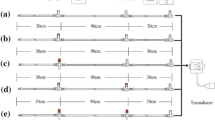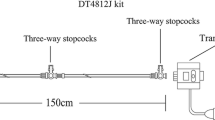Abstract
Blood pressure transducer kits are equipped with two types of Planecta™ ports—the flat-type Planecta™ port (FTP) and the Planecta™ port with a three-way stopcock (PTS). We reported that FTP application decreased the natural frequency of the kits. However, Planecta™ is an invaluable tool as it prevents infection, ensures technical simplicity, and excludes air. Hence, an ideal Planecta™ port that does not decrease the frequency characteristics is required. As a first step in this direction, we aimed to assess the influence of PTSs on the natural frequency of blood transducer kits. A DTXplus transducer kit (DT4812J; Argon Medical Devices, TX, USA) was used along with ≥1 PTSs (JMS, Hiroshima, Japan), and the frequency characteristics were assessed. The natural frequency and damping coefficient of each kit were obtained by using frequency characteristics analysis software, and these parameters were evaluated by plotting them on Gardner’s chart. Regardless of whether one or two PTSs were inserted, the natural frequency of the kits only slightly decreased (from 42.5 to 41.1 Hz, when 2 PTSs were used). Thus, the frequency characteristics of the kits with PTSs were adequate for pressure monitoring. The insertion of ≥2 FTPs in pressure transducer kits should be avoided, as they markedly decrease the natural frequency and lead to underdamping. However, the effect of PTS insertion in pressure transducer kits on the frequency characteristics is minimal. Thus, we found that the use of PTS markedly improved the frequency characteristics as compared to the use of FTP.








Similar content being viewed by others
References
Gravenstein SJ, Paulus AD. Clinical monitoring practice. 2nd ed. Philadelphia: J. S. Lippincott Company; 1987.
William TM, Jan MH, John AF. Quick guide to cardiopulmonary care. 2nd ed. California: Edwards Life sciences; 2009.
Fujiwara S, Kawakubo Y, Mori S, Tachihara K, Toyoguchi I, Yokoyama T. Effect of planecta and ROSE™ on the frequency characteristics of blood pressure-transducer kits. J Clin Monit Comput (Open access). 2014;. doi:10.1007/s10877-014-9650-y.
Crow S, Conrad SA, Chaney-Rowell C, King JW. Microbial contamination of arterial infusions used for hemodynamic monitoring: a randomized trial of contamination with sampling through conventional stopcocks versus a novel closed system. Infect Control Hosp Epidemiol. 1989;10:557–61. doi:10.2307/30144237.
Watanabe H, Yagi S, Namiki A. Recommendation of a clinical impulse response analysis for catheter calibration-dumping coefficient and natural frequency are incomplete parameters for clinical evaluation. J Clin Monit Comput. 2006;20:37–42. doi:10.1007/s10877-005-9008-6.
Gardner RM. Direct blood pressure measurement—dynamic response requirements. Anesthesiology. 1981;54:227–36. doi:10.1097/00000542-198103000-00010.
Todorovic M, Jensen EW, Thøgersen C. Evaluation of dynamic performance in liquid-filled catheter systems for measuring invasive blood pressure. Int J Clin Monit Comput. 1996;13:173–8. doi:10.1023/A:1016903508976.
Romagnoli S, Romano SM, Bevilacqua S, Lazzeri C, Gensini GF, Pratesi C, Quattrone D, Dini D, De Gaudio AR. Dynamic response of liquid-filled catheter systems for measurement of blood pressure: precision of measurements and reliability of the Pressure Recording Analytical Method with different disposable systems. J Crit Care. 2011;26:415–22. doi:10.1016/j.jcrc.2010.08.010.
Gersh BJ. Measurement of intravascular pressure. In: Prys-Roberts C, editor. The circulation in anaesthesia. Applied physiology and pharmacology. Oxford: Blackwell Scientific Publications; 1980. p. 511–8.
Watanabe H. A theory and practice for the accurate arterial blood pressure measurement. Life Support Anesth. 2007;14:630–4.
Runciman WB, Rutten AJ, Ilsley AH. An evaluation of blood pressure measurement. Anaesth Intensive Care. 1981;9:314–25.
Acknowledgments
This work was supported by intradepartmental funds. No external financial support was obtained. We thank JMS for information dissemination, and Editage for editing the manuscript.
Author information
Authors and Affiliations
Corresponding author
Ethics declarations
Conflict of interest
The authors have no conflicts of interest to declare.
Rights and permissions
About this article
Cite this article
Fujiwara, S., Tachihara, K., Mori, S. et al. Effect of using a Planecta™ port with a three-way stopcock on the natural frequency of blood pressure transducer kits. J Clin Monit Comput 30, 925–931 (2016). https://doi.org/10.1007/s10877-015-9795-3
Received:
Accepted:
Published:
Issue Date:
DOI: https://doi.org/10.1007/s10877-015-9795-3




